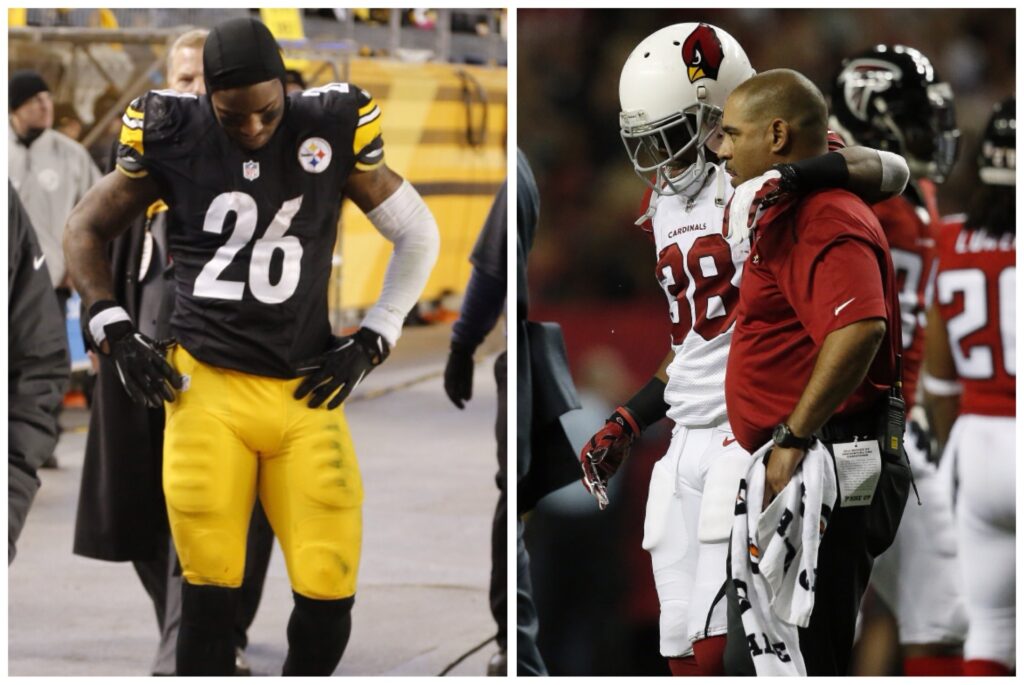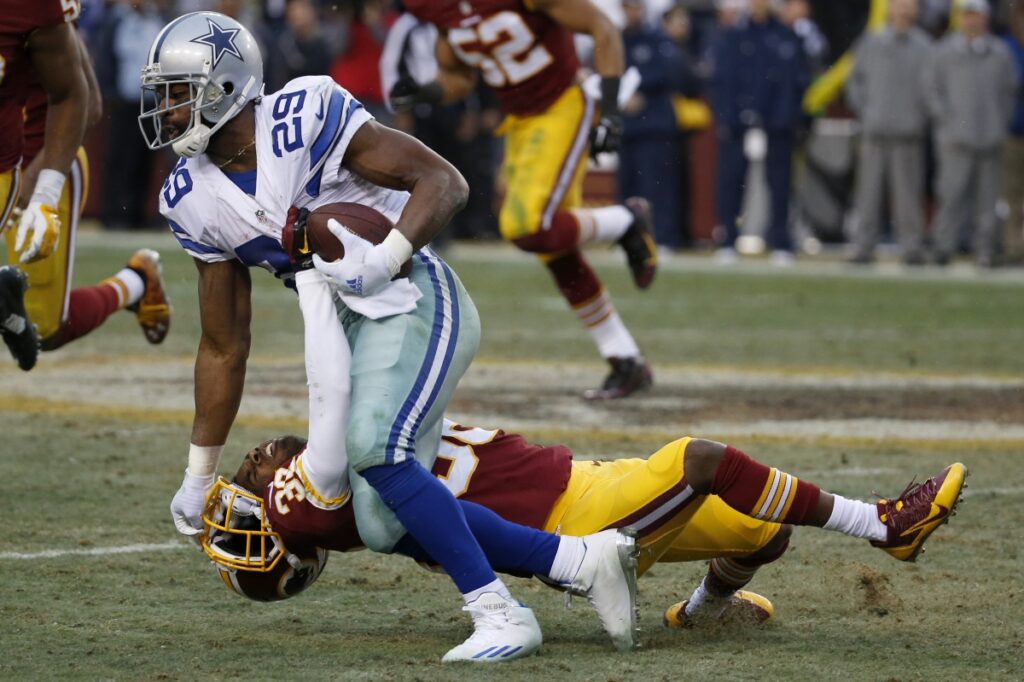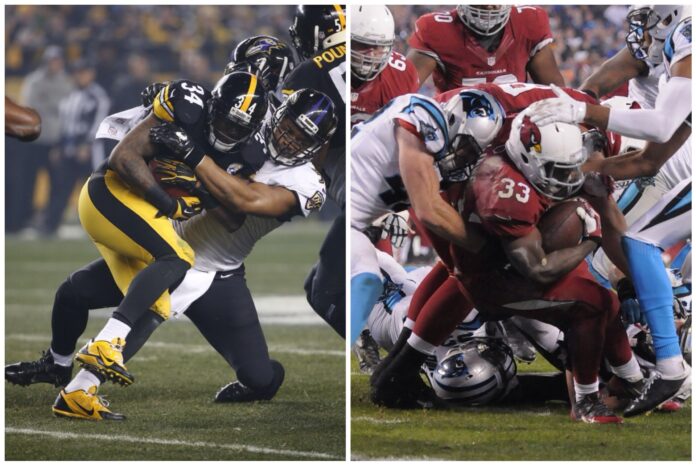“Passing League” Proves Once Again it Relies on the Run Game
So, it seems like the prevailing notion is that the NFL has become predominantly focused on passing.
I’m pretty certain I’ve discussed and debated this misconception on various occasions over the past year.
However, it’s a belief that requires consistent debunking, akin to prodding a stubborn creature until it finally retreats, especially after witnessing the events of yesterday’s wild-card playoff games.
The Steelers’ season abruptly ended with the loss of All-Pro running back Le’Veon Bell.
This forced them to rely more heavily on Ben Roethlisberger, whose two interceptions ultimately decided the game.
While Big Ben had one of his most productive seasons as a professional, his style of play remained consistent.
The significant change for the team was the addition of the dynamic playmaker, Bell, in the backfield, which opened up additional passing opportunities.
In the wild-card game against the Ravens, their offense became much more one-dimensional without this crucial element, leading to a screeching halt in their season.
In yesterday’s other match, Arizona displayed a disconcerting inefficiency in moving the football, surpassing even the struggles that have defined most of their games this season.
The apparent explanation for the Cardinals’ woes points to third-string quarterback Ryan Lindley, and there’s no excusing his performance… it was historically dismal.
However, when you consider they only managed 27 total yards rushing, even the most inexperienced quarterback on the planet would have desperately needed a running game that simply wasn’t there.
A more substantial ground game, coupled with a solid defense, can significantly lighten the load for a young quarterback and his pass protectors.
But despite a meaningful rushing attack, Saturday’s display was predictably weak.
This season in Arizona will be remembered for the quarterback injury woes that plagued the Cardinals, but that’s just part of the larger narrative.
The Cardinals lacked the necessary talent in the backfield, which proved to be a significant handicap throughout the season.
While Andre Ellington possessed the most skill among their running backs, his petite frame and proficiency in pass-catching don’t align with the typical profile of an every-down back in the NFL.
Ellington grappled with injuries and inconsistency throughout the season, culminating in his placement on injured reserve on December 7th due to a hernia that necessitated surgery.
The drop in quality from Ellington to the other backs they tried to extract production from proved a significant obstacle for this offense, even if it didn’t draw as much attention as the quarterback changes.

It might seem obvious, but it’s worth stating that superior running backs excel at gaining ground compared to their less skilled counterparts. When you entrust the ball to a more accomplished running back, they cover more distance.
I can’t believe I had to articulate that, but it was oddly satisfying to express.
I’ve been away from the NFL for quite a few years now. If my football knowledge only extended back to 2009 as a spectator, I might have mistakenly believed that the identity of the running back didn’t significantly impact the game.
They’d all be interchangeable, akin to mere “commodities.” However, based on my experience, I can attest that top-tier backs are more elusive to bring down, adept at finding yards in situations where they aren’t readily available, and undeniably elevate an NFL offense.
It’s peculiar that this truth seemed to have been overlooked, but it never ceased to hold true.
Yes, there are rare instances like the Patriots’ Jonas Gray, whose rugged style perfectly meshed with a specific game’s circumstances, particularly against a vulnerable defensive front seven of the Indianapolis Colts.
Yet, using isolated incidents with exceptional matchups and performances to argue against the need for investing in talent is a profoundly flawed perspective.
The Steelers and Cardinals’ seasons firmly debunk that misguided notion.
In a surprising turn of events, individuals in the NFL community tend to overreact to specific developments.
The emphasis on passing isn’t a recent phenomenon, and a future offense exclusively fixated on passing is bound to falter.
It’s not a viable future at all. Nothing enhances your quarterback’s performance quite like a robust running game and an offensive line that doesn’t have to focus solely on pass protection. That’s just plain science!
Somehow, there emerged a recent notion that prioritizing passing was a modern approach while running the football was considered old-fashioned or something of the sort.
This led to the misguided belief that since running was viewed as traditional, it should now play a diminished role in the game, and consequently, there was no need to invest in individuals highly skilled in this aspect.
It’s not just absurd, but this notion of a “passing league” contradicted all my experiences in the game, prompting me to delve into it.
Below is a chart illustrating the percentages of running plays in the NFL for the year 2000, as well as for each of the past five years.
In 2000, the run game percentage stood at 45.54%, indicating that teams across the league threw the ball approximately 55% of the time, on average.
Fifteen years have passed, and the run game percentages have only increased by two percentage points. Just two.
Quite the heralded wave of the future, isn’t it? If you commit to working out two percent more as a New Year’s resolution, you’ll still essentially be the same person… that’s a given.
If you reduce smoking by 2%, you’re still a smoker. Even if I were to diligently handle 2% more of the dishes in my household, my wife wouldn’t suddenly mistake me for Mr. Belvedere. Two percent hardly makes a significant difference.
The NFL operates in cycles; that much is clear. However, as the notion of slightly favoring passing was popularly portrayed as akin to Marty McFly’s hoverboard, the fundamental realities of football remained unaltered.
You still need to move the ball from point A to point B. The dimensions of the field are static.
Time travel won’t secure you a first down. It’s a simple choice: either pass it, which offers greater rewards but introduces a higher risk in ball handling, or run it, sacrificing the possibility of a big play for a higher level of certainty.
It’s not as complicated as it may seem. These fundamentals are unchangeable and timeless.
In today’s two games, the significance of the run game in football was unmistakable.
A revitalized Cowboys team took the field at home, boasting the league’s top rusher and a substantial investment in their offensive line to fortify this strength.
Without this dynamic, the conversation would likely revert to the old Tony Romo error narrative. Yet, with it, Big D has a palpable sense of hope.

The Lions are led by Matthew Stafford at quarterback, but they perform at their peak when he isn’t throwing the ball 35+ times per game.
Their situation is particularly challenging due to their beleaguered offensive line, which has faced as many challenges as the Cardinals’ quarterback position.
This makes it difficult to fully utilize the talent they possess in Joique Bell and a now-healthy Reggie Bush in the backfield.
Their entire dynamic shifts when they achieve productivity in the run game.
Despite having the game’s top wide receiver in Calvin Johnson, a dependable workhorse in Golden Tate, and skilled tight ends, they operate as an average offense when they struggle to establish a running game. It’s just the nature of football.
The Bengals have thrived thanks to their dual threat in the backfield with Jeremy Hill and Giovani Bernard.
If it were solely the Andy Dalton show, especially in the absence of AJ Green, the outcome of their wild-card round game would be pretty predictable.
However, they stand a genuine chance on the road in the playoffs because they possess the ability to run the football, even without their top pass-catcher effectively.

On the flip side, the Colts have recently exhibited a level of play as lackluster as any playoff-bound team.
Their misfortune can be attributed to their struggles in advancing the ball on the ground and thwarting opponents’ running attacks.
Despite possessing the NFL’s prized new passing weapon in Andrew Luck, their success in the grand scheme hinges on their ability to excel in all facets of the NFL running game.
It would be an equally exaggerated response to hinge everything on the running game, just as the “passing league” concept suggests.
That’s not my point. It’s essential to demonstrate proficiency in running and passing, and those who excel at this dual-threat are particularly formidable.
This season has served as a reminder that football remains fundamentally unchanged; nothing is genuinely groundbreaking or revolutionary.
The teams that grasp and excel in all aspects will persist in advancing, while the rest will bid farewell and prepare for the offseason.

